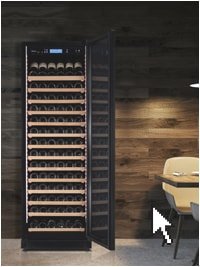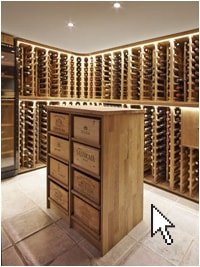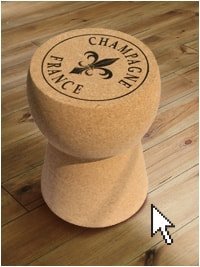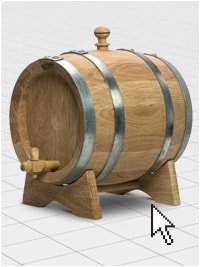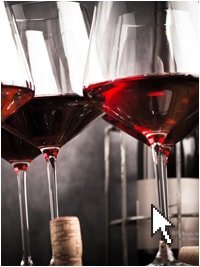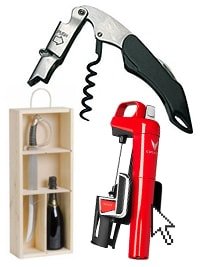Commissioning you wine barrel
Wine barrels in use
Before buying a wine barrel
Considerations before cask aging of wine
Should the wine be casked?
A great number of considerations must be made and decisions taken during the production of a wine. Here, I’ll describe some of the considerations you should make before investing in expensive oak barrels for wine. Many people associate quality wine with a wine that is aged in an oak barrel. This is true in many cases, but there are also many other things that need to be considered, such as: A thin and poor wine is not helped by being stored in barrels. In contrast, a wine of truly ripe grapes, a powerful wine, a wine that is already good, has the potential to gain even more by barrels aging.
What does an oak barrel do to wine?
When stored in an oak barrel, wine reacts through a number of chemical processes with the barrel. The result is a more durable and stable wine with a more full-bodied, complex and concentrated palate. Color, for example, becomes intensified. The barrel imparts hundreds of different substances/chemicals to the wine. Some of the most important are tannin, sugar and vanilla aromas.
The barrel also has another, more indirect effect. It allows for a slow and controlled oxygenation (not oxidation) of the wine, which helps to give a rounded and mature wine. The oxygenation occurs both through the surface of the wood and through the bunghole. When wine is aged in a barrel there is constant gradual evaporation, while at the same time the wood absorbs the wine. Therefore, the barrel needs to be regularly replenished with the same wine. This process also adds to the oxygenation of the wine.Through evaporation of water and alcohol, the wine is further concentrated, and the fresh and raw fruit flavor becomes softer.
Oak barrels can be used for both white and red wines
However, certain types of white wine grapes are not suitable for cask aging. The most important thing about the grape is that it has a certain fullness and fruit rich characteristics, so that the wine is not "wiped out” by the oakiness of the barrel. Meaning that the flavors imparted by the barrel should not overwhelm the grape flavor. This is why you should only use fruity and intense wines for aging in oak barrels.
French, American or Hungarian oak?
Oak barrels of different species and origin are available. French oak casks are the most prevalent globally, the wood being harvested from forests in central France. Previously, many people believed that French oak was the best and the only suitable wood for cask aging of wine, but recently Eastern European oak has also begun to be highly regarded. In particular, Hungarian oak, partly because Hungary has highly skilled coopers, but also because Hungary produces wood with a very fine grain and "taste". In addition to which Hungarian barrels are significantly less expensive than French barrels. American oak is also a great and good value alternative, especially if you want a more pronounced flavor of vanilla from the barrel.
Toasting of a barrels
A crucial role in how the barrel impacts on the wine is often played by the degree to which it is toasted. When the barrel is roasted using an open fire, a chemical transformation of substances in the oak surface takes place. The more toasted it is, the more smokiness will be imparted to the wine. The most common level of toasting is called "medium" (M). What size wine barrel should I choose? Most small winemakers will say that it depends on how much wine you have. That’s very true. But if you have wine in larger quantities a barrel of around 225 liters volume is ideal. A 225 liter wine barrel gives the optimum ratio between the surface of the wood and the wine.
Smaller barrels of 30, 50 and 100 liters can also be easily used for cask aging, you just need to be ensure that there is a relatively large surface of wood in relation to the quantity of wine, which helps speed the process of aroma/taste exchange between the oak and the wine. It is therefore important that you regularly sample the wine to achieve the right balance of barrel flavor.
Commissioning you wine barrel
Preparing a new wine barrel for immediate use
When your wine barrel is delivered the wood is completely new and there may be a little sawdust and sanding dust remaining in the barrel. It’s always best to remove this before filling the vessel with your precious liquids. Also, wood is a natural material in constant development, depending on temperature and humidity. Therefore, the wood needs to be "saturated" with water so that any small cracks can be sealed as it expands. It's something of a personal choice which method you think is best, but here are 2 options.
Some people use only method A, others only method B, while some choose to use both. But it’s been my experience that method A is best to seal small cracks.
Method A:
1. Fill the barrel completely with cold water.
2. Leave the barrel filled for 48 hours.
3. Empty the barrel, rinse it with fresh water and let it drain completely. If any sawdust emerges when you empty the barrel, repeat with more rinses.
Method B:
1. Fill the barrel with approximately 20 liters of very hot water (175 ° F / 80 ° C).
2. With the barrel upright, rotate both ends for at least two full turns. The bung must be in place.
3. Place the barrel with bunghole downwards and move it from side to side, allowing the barrel to slosh the water around inside. Repeat this action until the barrel has made four complete revolutions. Remove the bung and allow the barrel to drain completely.
What do you do if a leak occurs?
1. Empty the barrel completely and let it dry for about an hour with bunghole downwards.
2. Repeat testing the barrel with method B, as seen in "Barrel preparation for immediate use".
3. Empty the barrel, rinse it with fresh water and let it drain completely.
Using a used wine barrel
Investigate the barrel for unwanted odors - particularly if it smells of vinegar.
If you are unsure about the barrel’s suitability due to the smell then it’s best not to use it. Otherwise, you may risk destroying your precious wine.
Afterward, follow the procedure in "Preparing the new aging barrel for immediate use”.
Wine barrels in use
Remember to replenish the "angels' share" (a little liquid is always lost through evaporation). How often this needs to be performed depends on several factors including humidity and the size of the barrel. Start by checking after approx. 1 week and then find your own routine. If you spill some wine on the wine barrel, wipe it off immediately, so it does not attract flies and discolour the wine barrel.
Cleaning of used wine barrels
You can do this using the following methods:
Method A:
- Rinse the barrel several times with cold water until the waste water runs clear. If the barrel is very dirty you can use soda. Then rinse with plenty of water.
- Lay the barrel bunghole downwards and allow it to dry completely.
- Treat with sulfur, 10-20 grams sulfur sticks per barrel. Treat with sulfur regularly approx. every 4-6 weeks.
Method B:
- Begin by rinsing the barrel out with cold water and then with very hot water (175 ° F / 80 ° C) until the water runs clear.
- Lay the barrel bunghole downwards and allow it to dry completely.
- Treat with sulfur, 10-20 grams sulfur sticks per barrel.. Treat with sulfur regularly approx. every 4-6 weeks.
Note: Our barrels have not been sulfur treated on delivery as they are brand new. Small barrels can be cleaned with water and sulfur powder, approx. 1 gram per 5 liters of water.
Wine Barrel Storage
1. If you plan on storing a new wine barrel, you may want to leave it wrapped in foil. A used wine barre, though, should preferably be able to "breathe”. Wrap it, if necessary, in an old blanket or something similar in order to protect it from light.
2. Ideally, you should store wine barrels in a location with the following characteristics: Humidity of about 70-80%. The absence of moving air currents. Low light. Covered with a blanket to avoid unnecessary exposure to UV light.
3. After a longer storage period, prepare your wine barrel using Method A, as seen in "Barrel preparation for immediate use”.
4. Remember to burn sulfur inside every 4-6 weeks. Order sulfur sticks here.
After 1st year of barrel aging
The influence of the barrel in terms of notes from the oak will decrease after the first year of storage.
A rule of thumb is that the wine should have twice as much time in its second year if you want achieve the same intensity as the first year’s storage. Alternatively, you can boost the intensity by adding oak chips to the cask.
You can order oak chips here.
















